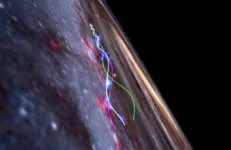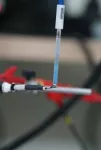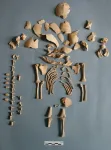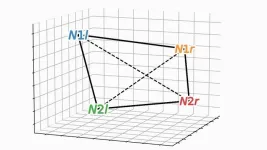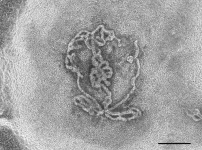(Press-News.org)
A few years ago, astronomers uncovered one of the Milky Way’s greatest secrets: an enormous, wave-shaped chain of gaseous clouds in our sun’s backyard, giving birth to clusters of stars along the spiral arm of the galaxy we call home.
Naming this astonishing new structure the Radcliffe Wave, in honor of the Harvard Radcliffe Institute, where the undulation was originally discovered, the team now reports in Nature that the Radcliffe Wave not only looks like a wave, but also moves like one – oscillating through space-time much like “the wave” moving through a stadium full of fans.
Ralf Konietzka, the paper’s lead author and Ph.D. student at Harvard’s Kenneth C. Griffin Graduate School of Arts and Sciences, explains, “By using the motion of baby stars born in the gaseous clouds along the Radcliffe Wave, we can trace the motion of their natal gas to show that the Radcliffe Wave is actually waving.”
Back in 2018, when University of Vienna professor João Alves was a fellow at Harvard Radcliffe Institute, he worked with Center for Astrophysics researcher Catherine Zucker – then a Ph.D. student at Harvard – and Alyssa Goodman, Robert Wheeler Willson Professor of Applied Astronomy, to map out the 3D positions of the stellar nurseries in the sun’s galactic neighborhood. By combining brand-new data from the European Space Agency’s Gaia mission with the data-intensive “3D Dust Mapping” technique – pioneered by Harvard professor Doug Finkbeiner and his team – they noticed a pattern emerging, leading to the discovery of the Radcliffe Wave in 2020.
“It’s the largest coherent structure that we know of, and it’s really, really close to us,” said Zucker, who describes the collaboration’s work in a related Sky and Telescope article. “It’s been there the whole time. We just didn’t know about it, because we couldn’t build these high-resolution models of the distribution of gaseous clouds near the sun, in 3D.”
The 2020 3D dust map clearly showed that the Radcliffe Wave existed, but no measurements available then were good enough to see if the wave was moving. But in 2022, using a newer release of Gaia data, Alves’ group assigned 3D motions to the young star clusters in the Radcliffe Wave. With the clusters’ positions and motions in hand, Konietzka, Goodman, Zucker and their collaborators were able to determine that the entire Radcliffe Wave is indeed waving, moving like what physicists call a "traveling wave."
A traveling wave is the same phenomenon we see in a sports stadium when people stand up and sit down in sequence to “do the wave.” Likewise, the star clusters along the Radcliffe Wave move up and down, creating a pattern that travels through our galactic backyard.
Konietzka continued, “Similar to how fans in a stadium are being pulled back to their seats by the Earth's gravity, the Radcliffe Wave oscillates due to the gravity of the Milky Way.”
Understanding the behavior of this 9,000 light year-long, gargantuan structure in our galactic backyard, just 500 light-years away from the sun at its closest point, allows researchers to now turn their attention to even more challenging questions. No one yet knows what caused the Radcliffe Wave or why it moves the way it does.
“Now we can go and test all these different theories for why the wave formed in the first place," Zucker said.
“Those theories range from explosions of massive stars, called supernovae, to out-of-galaxy disturbances, like a dwarf satellite galaxy colliding with our Milky Way”, Konietzka added.
The Nature article also includes a calculation on how much dark matter might be contributing to the gravity responsible for the wave’s motion.
"It turns out that no significant dark matter is needed to explain the motion we observe," Konietzka said. “The gravity of ordinary matter alone is enough to drive the waving of the wave."
In addition, the discovery of the oscillation raises new questions about the preponderance of these waves both across the Milky Way and other galaxies. Since the Radcliffe Wave appears to form the backbone of the nearest spiral arm in the Milky Way, the waving of the wave could imply that spiral arms of galaxies oscillate in general, making galaxies even more dynamic than previously thought.
“The question is, what caused the displacement giving rise to the waving we see?” Goodman said. “And does it happen all over the galaxy? In all galaxies? Does it happen occasionally? Does it happen all the time?”
The National Science Foundation, NASA, ESA, and the European Research Council (ERC) Advanced Grant ISM-FLOW supported this work.
END
About The Study: Housing instability, as measured by eviction filings, was associated with a significantly increased risk of death over the first 20 months of the COVID-19 pandemic in this study that included 282,000 renters who received an eviction filing. Eviction prevention efforts may have reduced excess mortality for renters during this period.
Authors: Nick Graetz, Ph.D., of Princeton University in Princeton, New Jersey, is the corresponding author.
To access the embargoed study: Visit ...
WASHINGTON, Feb. 20, 2024 — The freshness of animal meat is an essential property determining its quality and safety. With advanced technology capable of preserving food for extended periods of time, meat can be shipped around the globe and consumed long after an animal dies. As global meat consumption rates increase, so too does the demand for effective measures for its age.
Despite the technological advances keeping meat fresh for as long as possible, certain aging processes are unavoidable. Adenosine triphosphate (ATP) ...
An international genetic study using multiancestry biobanks has identified novel genetic locations associated with primary open-angle glaucoma (POAG), the most common type of glaucoma and the leading cause of irreversible blindness globally. The findings, published Feb. 20 in Cell Reports Medicine, detail ancestry- and sex-specific genetic loci associated with POAG and implicate vascular and cancer-related genes in POAG risk.
“Although there has been significant progress using genome-wide association studies (GWAS) to explore the genetic pathophysiology of glaucoma in humans, there is still a lack of understanding of the underlying ...
About The Study: The results of this study suggest that human papillomavirus (HPV) vaccination coverage among young adults did not increase during the COVID-19 pandemic compared with prior years. This finding likely reflects pandemic-related disruptions in initiating the HPV vaccine among young adults.
Authors: Kalyani Sonawane, Ph.D., of the Medical University of South Carolina in Charleston, is the corresponding author.
To access the embargoed study: Visit our For The Media website at this link https://media.jamanetwork.com/
(doi:10.1001/jamanetworkopen.2023.56875)
Editor’s Note: Please see the article for ...
About The Study: In a study of 1,764 women with breast cancer, living in a historically redlined area was associated with increased odds of a diagnosis of estrogen receptor–negative breast cancer in non-Hispanic Black women and increased odds of late-stage diagnosis in non-Hispanic white women. Persistent mortgage discrimination was associated with an increase in breast cancer mortality in non-Hispanic white women, and non-Hispanic Black women were more likely to die of breast cancer no matter where they lived.
Authors: Jasmine M. Miller-Kleinhenz, Ph.D., of Emory University in Atlanta, is the corresponding author.
To ...
For many years, researchers at MPI-EVA have been collecting and analyzing ancient DNA from humans who lived during the past tens of thousands of years. Analyzing these data has allowed the researchers to trace the movement and mixing of people, and even to uncover ancient pathogens that affected their lives. However, a systematic study of uncommon genetic conditions had not been attempted. One of those uncommon conditions, known as Down Syndrome, affects nowadays around one in 1,000 births.
To their surprise, Adam “Ben” Rohrlach and colleagues identified six individuals ...
NEW YORK, NY — The human brain has the extraordinary ability to rapidly discern a stranger from someone familiar, even as it can simultaneously remember details about someone across decades of encounters. Now, in mouse studies, scientists at Columbia's Zuckerman Institute have revealed how the brain elegantly performs both tasks.
“These findings are the first evidence that a single population of neurons can use different codes to represent novel and familiar individuals,” said co-corresponding author Stefano Fusi, PhD, professor of neuroscience at Columbia’s Vagelos College of Physicians and ...
Kale fans can rest easy knowing pesticides used to grow the hearty greens are unlikely to end up in their salads or smoothies, a new chemical analysis of the superfood suggests.
Conducting novel tests that provide the most complete picture to date of a crop’s chemical makeup, the Johns Hopkins–led team found several pesticides and compounds in Maryland-farmed kale—but no cause for alarm.
“We do see minute traces of pesticides in the kale, but the levels we found are so much lower ...
Key takeaways
A UCLA-led research team found a correlation between certain aspects of early puberty in first-born daughters and high levels of prenatal stress in their mothers.
The researchers did not find the same result in boys or in daughters who were not first-born.
This early maturation may enable a first-born daughter to help her mother rear her other children successfully, according to UCLA anthropologist Molly Fox.
A UCLA-led team of researchers has found a correlation between early signs of adrenal puberty in first-born daughters ...
The testis is responsible for sperm production and testosterone synthesis. Abnormalities in testis development and function lead to disorders of sex development (DSD) and male infertility. Currently, no in vitro system exists for modeling the testis.
Dr. Nitzan Gonen, a researcher specializing in the process of fetal sex determination, together with research students Aviya Stopel, Cheli Lev and Stav Dahari, has succeeded in creating "laboratory testicles" that may significantly advance understanding of the mechanisms involved in sex determination and provide solutions for male infertility, which affects one in 12 men worldwide.
The artificial testicles ...


